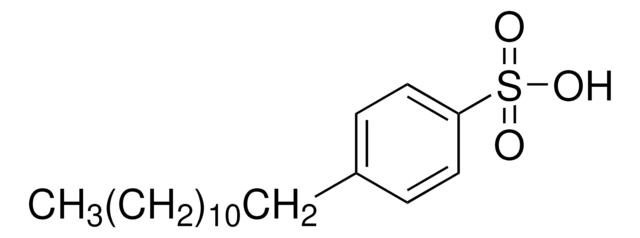09887
Ammonium lauryl sulfate solution
~30% in H2O (T)
Synonyme(s) :
Ammonium dodecyl sulfate, Dodecyl sulfate ammonium salt
About This Item
Produits recommandés
Description
anionic
Niveau de qualité
Forme
liquid
Poids mol.
283.43 g/mol
Concentration
~30% in H2O (T)
Couleur
Colorless to Very Light Yellow and Colorless to Very Light Green-Yellow
Indice de réfraction
n20/D 1.37
pH
6.8
Solubilité
water: soluble at 20 °C
Densité
1.02 g/mL at 20 °C
Application(s)
cleaning products
Température de stockage
15-25°C
Chaîne SMILES
N.CCCCCCCCCCCCOS(O)(=O)=O
InChI
1S/C12H26O4S.H3N/c1-2-3-4-5-6-7-8-9-10-11-12-16-17(13,14)15;/h2-12H2,1H3,(H,13,14,15);1H3
Clé InChI
BTBJBAZGXNKLQC-UHFFFAOYSA-N
Vous recherchez des produits similaires ? Visite Guide de comparaison des produits
Description générale
Application
- A catalyst in the synthesis of 1H-benzo[d]imidazole, quinoxaline, and 2,3-dihydro-1H-benzo[b][1,4]diazepine derivatives by reacting with benzene-1,2 diamine and aromatic aldehydes/1,2-diketones/ketones respectively.
- A corrosion inhibitor for carbon steel and copper in acidic solution.
- A surfactant in the fabrication of porous ceramics by gel casting.
Mention d'avertissement
Warning
Mentions de danger
Conseils de prudence
Classification des risques
Aquatic Chronic 3 - Eye Irrit. 2 - Skin Irrit. 2
Code de la classe de stockage
10 - Combustible liquids
Classe de danger pour l'eau (WGK)
WGK 3
Point d'éclair (°F)
Not applicable
Point d'éclair (°C)
Not applicable
Faites votre choix parmi les versions les plus récentes :
Déjà en possession de ce produit ?
Retrouvez la documentation relative aux produits que vous avez récemment achetés dans la Bibliothèque de documents.
Notre équipe de scientifiques dispose d'une expérience dans tous les secteurs de la recherche, notamment en sciences de la vie, science des matériaux, synthèse chimique, chromatographie, analyse et dans de nombreux autres domaines..
Contacter notre Service technique







